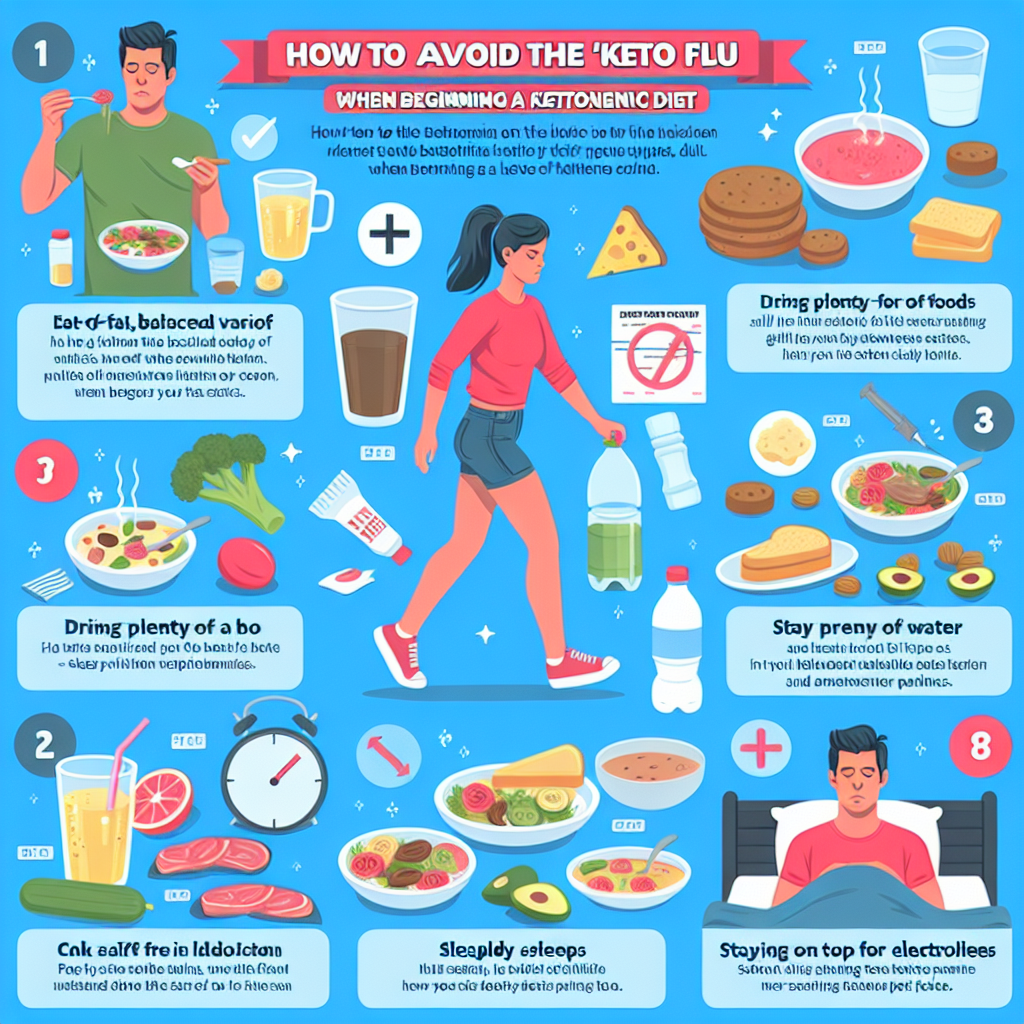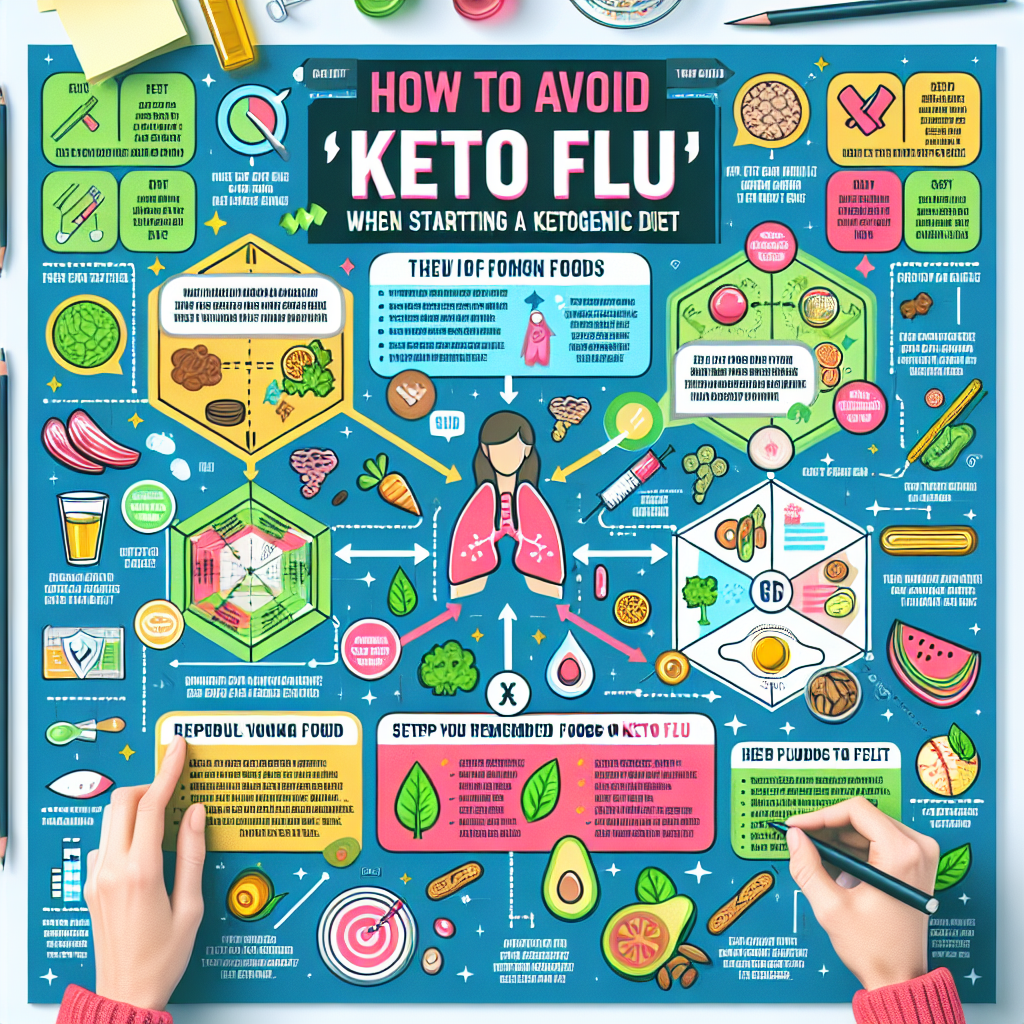How to Avoid Keto Flu When Starting a Keto Diet

Discover how to avoid the Keto Flu when starting a Keto Diet. Learn the best practices, tips, and tricks to ensure a smooth transition into your new lifestyle. Don’t let the initial discomfort deter you from your health goals. Visit My Vibrant Vitality now for more information.
Overcoming Initial Challenges: How to Avoid Keto Flu When Starting a Keto Diet
The ketogenic diet, popularly known as the keto diet, has gained significant attention in recent years due to its potential benefits for weight loss, diabetes management, and overall health improvement. However, as with any significant dietary change, the initial transition to a keto diet can present some challenges. One of the most common issues faced by beginners is the so-called “keto flu.” This article aims to provide practical advice on how to avoid this unpleasant experience when starting a keto diet.
The term “keto flu” refers to a collection of symptoms that some people experience when they first start a ketogenic diet. These symptoms, which can include fatigue, headache, nausea, dizziness, and irritability, are typically temporary and are thought to be related to the body’s adjustment to a dramatic reduction in carbohydrate intake. The good news is that there are several strategies that can help you avoid or at least minimize these symptoms.
Firstly, it’s crucial to stay well-hydrated. The keto diet can have a diuretic effect, meaning it can cause increased urination which can lead to dehydration if not properly managed. Drinking plenty of water, along with beverages like herbal tea or bone broth, can help maintain hydration levels and alleviate some of the symptoms of keto flu.
Secondly, maintaining a balanced intake of electrolytes is essential. When you start a keto diet, your body’s electrolyte balance can be disrupted, leading to symptoms like headaches and fatigue. To counteract this, consider adding foods rich in electrolytes, such as avocados and leafy green vegetables, to your diet. In some cases, an electrolyte supplement may also be beneficial.
Thirdly, it’s important to remember that the transition to a keto diet doesn’t have to be abrupt. Gradually reducing your carbohydrate intake over a period of weeks can give your body more time to adjust, potentially reducing the severity of keto flu symptoms. This approach, known as a “slow transition,” can be particularly helpful for those who are used to consuming a high-carb diet.
Another key strategy is to ensure you’re consuming enough calories. While the keto diet is often associated with weight loss, it’s not intended to be overly restrictive in terms of calorie intake. Consuming too few calories can exacerbate keto flu symptoms, so it’s important to ensure you’re eating enough nutrient-dense, high-fat foods to meet your energy needs.
Lastly, getting plenty of rest can also help your body adjust to the changes brought about by a keto diet. Adequate sleep can help alleviate symptoms like fatigue and irritability, and can also support overall health and well-being.
In conclusion, while the initial transition to a keto diet can be challenging, the potential benefits of this dietary approach can make it well worth the effort. By staying well-hydrated, maintaining a balanced intake of electrolytes, gradually reducing carbohydrate intake, ensuring adequate calorie consumption, and getting plenty of rest, you can help your body adjust more smoothly to a ketogenic diet and avoid the unpleasant symptoms of keto flu. As always, it’s important to consult with a healthcare professional before starting any new diet or nutrition plan.
Navigating the Keto Transition: Effective Strategies to Prevent Keto Flu

The ketogenic diet, popularly known as the keto diet, has gained significant attention in recent years due to its potential benefits for weight loss, diabetes management, and overall health improvement. However, as with any significant dietary shift, transitioning to a keto diet can present challenges. One such challenge is the so-called “keto flu,” a collection of symptoms that can occur in the early stages of the diet. Fortunately, there are effective strategies to prevent or mitigate these symptoms, making the transition to a keto lifestyle smoother and more comfortable.
The keto flu is not a flu in the traditional sense. Instead, it refers to a group of symptoms that some people experience when they first start a keto diet. These symptoms can include fatigue, headache, irritability, difficulty focusing (“brain fog”), lack of motivation, dizziness, and digestive discomfort. These symptoms are typically temporary, lasting a few days to a week, as your body adjusts to burning fat for fuel instead of carbohydrates.
One of the most effective strategies to prevent keto flu is to ensure adequate hydration. The shift to a ketogenic diet can lead to increased water loss, which can, in turn, lead to dehydration if not properly managed. Therefore, it’s crucial to increase your water intake during the transition period. Additionally, consuming beverages with electrolytes, such as bone broth or sugar-free sports drinks, can help maintain electrolyte balance and prevent symptoms like headaches and fatigue.
Another key strategy is to gradually reduce your carbohydrate intake rather than making a sudden, drastic change. This approach allows your body to slowly adjust to the new way of eating, which can help prevent or lessen the severity of keto flu symptoms. Start by eliminating obvious sources of carbs like bread and pasta, then gradually cut back on less obvious sources like fruits and vegetables.
Proper sleep and stress management are also essential during the transition to a keto diet. Lack of sleep and high stress levels can exacerbate keto flu symptoms, making the transition more challenging. Therefore, it’s important to prioritize good sleep hygiene and incorporate stress-reducing activities into your routine, such as yoga, meditation, or simply taking time for relaxation and leisure.
Finally, it’s important to remember that everyone’s body reacts differently to dietary changes. Some people may experience severe keto flu symptoms, while others may have none at all. Listening to your body and adjusting your approach as needed is crucial. If you’re feeling unwell, it may be necessary to increase your carb intake slightly or seek advice from a healthcare professional.
In conclusion, while the keto flu can be an uncomfortable part of transitioning to a ketogenic diet, it doesn’t have to be a deal-breaker. By staying hydrated, reducing carbohydrate intake gradually, prioritizing sleep and stress management, and listening to your body, you can navigate the keto transition effectively and reap the potential benefits of this dietary approach. Remember, the keto flu is temporary, but the potential health benefits of a well-managed keto diet can be long-lasting.
Starting Keto the Right Way: Tips to Dodge the Dreaded Keto Flu
Starting a ketogenic diet, popularly known as the keto diet, can be a transformative journey towards better health and weight loss. However, it’s not uncommon for beginners to experience a set of symptoms known as the “keto flu” during the initial stages. This article will provide you with valuable insights on how to avoid the dreaded keto flu when starting a keto diet.
The keto diet is a low-carb, high-fat diet that aims to shift your body’s metabolism from burning glucose to burning fats for energy. This metabolic state, known as ketosis, can lead to rapid weight loss. However, as your body adjusts to this new fuel source, you may experience flu-like symptoms such as fatigue, headache, nausea, and irritability. This is commonly referred to as the keto flu.
The good news is that the keto flu is not inevitable, and with the right strategies, you can minimize or even avoid these symptoms altogether. The first step is to ensure a gradual transition into the diet. Instead of drastically reducing your carbohydrate intake overnight, consider lowering it gradually over a week or two. This gives your body time to adjust to the new diet without triggering a shock response.
Hydration is another crucial factor in avoiding the keto flu. The shift into ketosis can cause your body to excrete more water and electrolytes, leading to dehydration if not properly managed. Therefore, it’s essential to increase your water intake and consider supplementing with electrolytes such as sodium, potassium, and magnesium.
Another effective strategy is to ensure adequate intake of fats. Since the keto diet relies on fats for energy, it’s important to consume enough healthy fats to fuel your body. This can help to curb cravings and reduce feelings of fatigue. Foods rich in healthy fats include avocados, nuts, seeds, and fatty fish.
Regular exercise can also help to mitigate the symptoms of the keto flu. Physical activity encourages your body to burn through its glycogen stores more quickly, speeding up the transition into ketosis. However, it’s important to listen to your body and not push yourself too hard, especially in the early stages of the diet.
Getting enough sleep is another important aspect of managing the keto flu. Lack of sleep can exacerbate symptoms such as fatigue and irritability. Therefore, it’s important to prioritize good sleep hygiene, including maintaining a regular sleep schedule and creating a calm, restful sleep environment.
Lastly, it’s important to remember that everyone’s body reacts differently to dietary changes. Some people may experience severe keto flu symptoms, while others may not experience any at all. It’s crucial to listen to your body and adjust your diet and lifestyle accordingly. If symptoms persist or become severe, it may be necessary to consult with a healthcare professional.
In conclusion, while the keto flu can be an uncomfortable side effect of starting a ketogenic diet, it’s not an inevitable part of the process. By gradually transitioning into the diet, staying hydrated, consuming enough healthy fats, exercising regularly, and prioritizing sleep, you can significantly reduce your chances of experiencing the keto flu. Remember, the key to a successful keto diet is patience and consistency. With the right approach, you can navigate the initial challenges and reap the long-term benefits of this powerful dietary strategy.